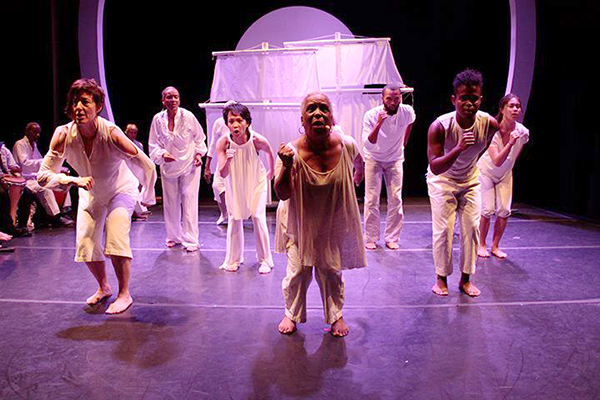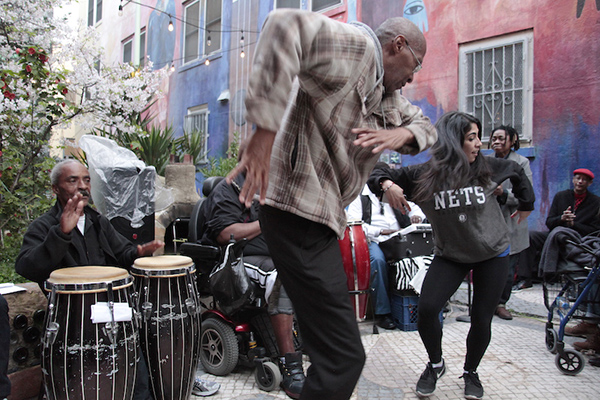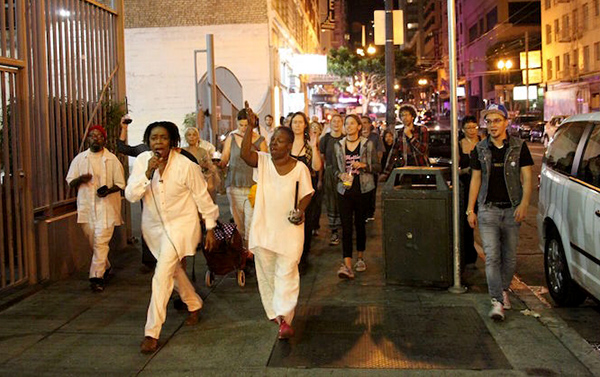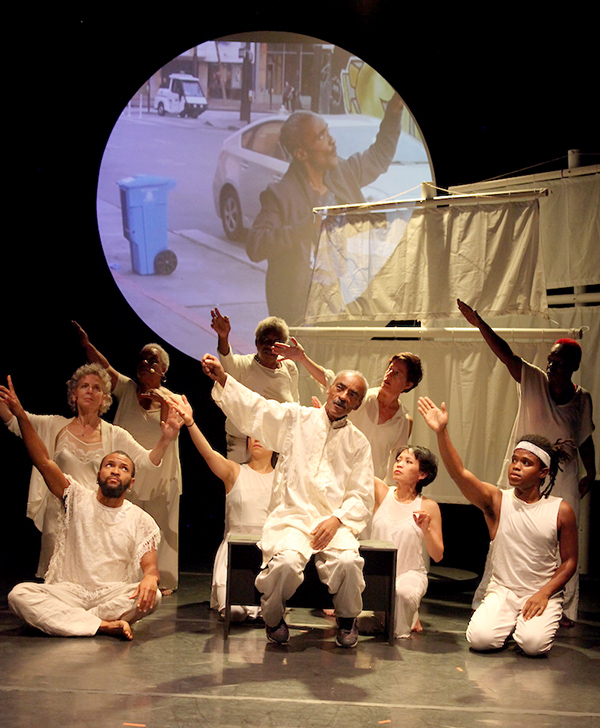Dancing Of, By and For the People
An Interview with Anne Bluethenthal
BY EMMALY WIEDERHOLT
Anne Bluethenthal is a dancer and choreographer in the Bay Area, and artistic director of ABD Productions and the Skywatchers Program, which brings residents of San Francisco’s Tenderloin District into partnership with professional artists to create multi-disciplinary, site-specific performance installations that amplify the rich and complex stories, life experiences and talents of community members. Here, she discusses how it all got started, as well as what it means to engage in community-based art.
~~
What is your dance background and how did it inspire you to initiate a program like Skywatchers?
I started making dances in the late 70s. From the beginning, it was my way of metabolizing life. I grew up in Greensboro, North Carolina during the civil rights movement. My parents were activists, and were instrumental in the desegregation of our town’s school system. Social justice was part of my life for as far back as I have memory.
Dance started as a very personal journey translating the politics of my youth into the psycho-physical discipline of dance. I explored how politics are embodied, and how our bodies are colonized by the dominant culture. Over three decades, my work grew more ambitious in subject and scope, addressing whatever social issues were burning for me at the moment. I’ve made work about subjects ranging from the environment to gender politics to genocide.
What was the impetus for starting Skywatchers?
I was searching for more lasting relationships in the creative process in terms of the impact art can make. I did a piece about genocide that involved a number of local, national and international organizations. It was a massive two-year project that engaged communities across the globe, but it was over in a matter of four days.
Most of the work people like me make in theaters is of the people but not by or for the people. They are subject matter but rarely creators or witnesses. I wanted to create more lasting relationships in the building of work, and to allow those most affected by the issues to be the people who were crafting and performing the work.
While contemplating this and exploring ways of entering and working in collaboration with community, I was also challenging the theater-economy of dance, which propelled me into a “Year of Guerilla Art: 50 Random Acts of Dance.” My dancers and I would leave the studio once a week, arrive at a unique site in the city, perform, and leave. It was a practice of giving dance away as a gift. By the end of the year, hungry to stay in one place, I landed at the Tenderloin National Forest, created by Darryl Smith and Laurie Glaser of Luggage Store Gallery. It’s a gorgeous living green art space, now over 15 years old. I wanted to make a piece there.
I started talking to people who lived in the adjacent Senator Hotel. As soon as I started to talk to people, my whole concept changed. I was no longer doing a site-specific piece; I was building relationships with people living in supportive housing SROs (single room occupancy hotels), which provide subsidized housing and support services to people who are not housed or who are low to no income.
After a successful first performance in the forest, more residents wanted to participate. Once people saw that the program was accessible, and that I wasn’t going anywhere, they became more interested. By the end of the first performance, I was coming every week with pizza and hanging out in the tenant lounges with whomever showed up.
The first person I interviewed, Janice Detroit, called herself a skywatcher because she lived in the top floor corner apartment. She told me she watches the sky and looks over the neighborhood, and she’s there to take the tears away from all the children below. She gave us permission to use the name Skwatchers for the program I was slowly developing. By the third year, it was a phenomenon in the neighborhood. People were starting to see it as their own ensemble.
How is Skywatchers organized?
I started at the Senator Hotel, bringing food and listening, capturing stories, insights, dreams, ideas, and spontaneous poetry or song as they arrived. By the end of the third year, I was also going to the Cambridge Hotel, and I started bringing another artist with me. Seven years later, we have five Skywatcher Artist Facilitators who spread out to six different SROs, plus a youth program at Larkin Street Youth Services. We work individually at our different sites, listening deeply, building relationships and making note of what seems urgent. We try to create art around those concerns. We do that individually at our respective sites, and we also come together collectively to discuss how to advance themes that are arising. Depending on the year, we usually have one large annual performance event, and five to six smaller events.
How has your own understanding of the Tenderloin community evolved?
My understanding of the Tenderloin hasn’t changed so much as deepened. I knew the Tenderloin was treated as the containment zone of San Francisco, into which we’ve pushed most of our people of color and most of our poor. I understood it as a place where people were afraid to go. I personally never felt afraid or threatened, but that’s probably partly my own privilege as well as my curiosity.
It is a harsh reality, the kind of poverty we have in our backyards. Getting to know so many amazing, brilliant, wise and talented people; listening to those stories every week has changed me. I’m passionate about making visible how the most vulnerable in our society live, and to celebrate the beauty, wisdom and brilliance of that community.
What obstacles have you faced keeping Skywatchers going?
Poverty is trauma. At any given moment, there’s the immediacy of people’s lives that we’re intersecting with and creating the space in which to discuss. Survival is the biggest challenge, how to support each other in surviving.
On a purely logistical level, residents don’t necessarily have phones or internet, so reaching people to let them know where to be at what time can be a challenge. They don’t have all the communication resources we take for granted. Sometimes just showing up is a heroic act.
Has your race and class influenced how you approach Skywatchers, especially being a white woman going into a community of color?
It’s a precarious position to put oneself in. I am very aware of the problematic nature of my presence. The way I look at it is: I’ve been doing anti-racist work since I was young; issues of race and privilege are part and parcel of the work I’ve been doing most of my life. To not put myself in an SRO where I am a conspicuously middle-aged, gray-haired white woman in a community of color would be easier in many ways. I believe we have to work together to make change. And too many people with privilege avoid interacting directly with those who are vulnerable, suffering and hurting in our society. I am interested in leveraging the privilege I have to expose, collaborate, agitate, support and create toward disrupting and making positive change. By just placing myself in the Tenderloin, I’m creating social change. I may be encountering problematic issues along the way, but I think those are the noble problems. I’ve been working in the TL for seven years on an almost daily basis. Creating trust across chasms of power and privilege takes time and commitment, and I’m excited about doing it.
What advice would you give to an artist who is interested in doing community-based work?
When I teach community practice, I have students start with their own identities. People with skin, class and education privilege often don’t know how to identify their own communities. I suggest starting with the communities in which you are naturally situated. What kind of work is being done in those communities, or what would you like to see? Start there. I spent several years getting my chops in my own communities. Getting chops and the accompanying confidence made it possible for me to go sit in an SRO and feel confident that whatever came up in the room, I would be able to craft into a piece of performance. There’s nothing beyond years of experience that will give you that.
So my advice is to have a practice you are deeply committed to, and to begin where you are situated. If you are called into a community that is different than your own, ask yourself if you’re being called by your own desires or by the desire and need of the community. Ask yourself what you’re offering as well as what you’re receiving. The mindset of helping can be one of the most damaging attitudes. Standing together, walking together in the struggle and, of course, creating together… it’s about radical reciprocity. And it’s about relationships. And it’s slow art—it can’t be done as a one off, so make sure you’ve got the capacity for durational, relational work. It’s the most rewarding thing going!
~~
To learn more, visit www.abdproductions.org.




